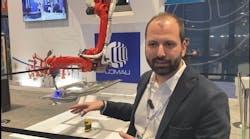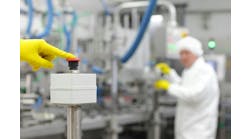As our machine controls grow more sophisticated and powerful, we think that we can and should provide additional data acquisition and monitoring capabilities beyond routine speed and rotational condition monitoring. We want to help willing customers obtain useful, real-time operating data, but we also want to capture some key operating variables that will help us design better-performing and more reliable machines. We've used standalone DAQ systems, and now are considering whether the data acquisition capabilities of PACs and newer PLCs might be a better path. We'd like to hear from others who have experience with both.
—From April '14 Control Design
Answers
You Can Leverage Both
Effective rotating equipment condition monitoring necessitates the intelligent amalgamation of machine and process variables with the capture of high-speed, qualitative analog sources. Typically, this process is undertaken by complex and costly condition monitoring systems that create additional barriers to value by removing the reliability analysis from those closest to the equipment.
Programmable automation controller (PAC) and data acquisition (DAQ) systems each offer unique advantages in terms of information access and in granularity. The greatest benefit is realized from those systems that leverage both to deliver accessible, yet comprehensive insight into the condition of the machinery. PACs provide a foundation to facilitate the collection of existing process machinery operating parameters and protection events. This information is leveraged most effectively, not in isolation, but when used to provide event-context interpretation supporting the understanding of more granular data available from high-speed DAQs.
Our company has successfully embodied its valued OEM machinery knowledge within our Envision condition monitoring system worldwide. The Envision suite unifies the advantages of both PACs and DAQs into an understandable, common user interface that provides accurate, timely diagnostic information to both operators and rotating equipment engineers alike.
Neil Anderson,
Global Integration Manager,
Dresser-Rand
Use a Unified System
Today, machine builders who seek to implement more advanced condition monitoring systems no longer have to rely on standalone, black-box systems. PC control, for example, represents one unified system to interface, collect, analyze, store and display the data for any monitoring and measurement application, from simple to advanced. Another advantage of PC-based control is that when today's modern multicore processors are paired with our standard TwinCAT software, it's rather easy to bundle this functionality with the meat and potatoes machine functionality, such as PLC, motion control, HMI and even things like robotics, all on one hardware device. Even better, users can intelligently separate the tasks to individual cores. The benefit here is that very specialized tasks such as condition monitoring can run without sacrificing the performance needed for the connected I/O hardware, the HMI driven by this same computer or any other inherent machine control functionality, all performed by one industrial PC (IPC).
Once the measured data has been collected and pre-conditioned, it can be handed off to a standard condition monitoring software library such as in our TwinCAT. This solution can expertly manage the frequency analysis, statistics and classification of the signal to be monitored. In the past, as I'm sure the reader is aware, this was done by very expensive, dedicated hardware front ends. Today, we offer I/O terminals with built-in measurement and condition monitoring functionality that are directly connected to the same I/O rail with the standard I/O system. These are easily programmed and parameterized using standard software libraries that can be fine-tuned to your specific application. This is all done in TwinCAT—the same software used for all programming, including PLC, motion control, safety, etc. All the real heavy lifting of the condition monitoring and measurement is done in software running on PC-based hardware, which is flexible and can more easily accommodate changes and customizations to the system.
The standard Beckhoff condition monitoring library has frequency analysis such as power spectrum, envelope and digital filtering. Added to the mix are statistics such as moments coefficients, crest factor, etc. Homomorphic signal processing is also available such as power cepstrum, complex cepstrum, etc. Classification abilities such as pattern recognition, discrete classification (go/no go), threshold monitoring, etc., are provided. Even the motion system can play a role here, providing very fast sampled data from many types of sensors for vibration (IEPE interface accelerometer), temperature, power measurement, general mV and mA analog signals, current, velocity and position signals from our drives, just to name a few.
So what do you really need to accomplish condition monitoring and advanced measurement in a PC-based environment? You need a standard computer, ideally an IPC designed for control system applications. You also need a standard fieldbus capable of transferring large volumes of information, as well as standard I/O interface terminals to connect your scientific sensors to. Finally, you need a software platform that is capable of performing all the control functions of a PLC and has standard IT interfaces should you wish to establish remote access/connectivity.
I suggest that the reader does his/her own “condition monitoring” of the available solutions from vendors on the market. I'd strongly recommend a solution that's integrated into the standard machine control platform, which reduces reliance on dedicated, highly specialized hardware, and limits reliance on multiple software platforms that require a higher degree of specialization on the part of programming engineers.
Kurt Wadowick,
I/O Systems product specialist,
Beckhoff Automation
Good Awareness
Before responding to how you capture the information, it's worth pausing to underscore the competitive importance of why you're capturing it. Anticipating your customers' connected enterprise goals and helping them capture data that can be converted into working information capital is a strategic approach we believe all machine builders should be considering. It's an added bonus that you're also seeking information that will help you further improve and differentiate the performance and reliability of your machines. All machine builders should be considering it because we're at an inflection point in the decades-long pursuit of the connected enterprise. Enabling technologies, including the Internet of Things and mobility, create tremendous opportunities for machine builders taking advantage and great competitive risks for those not preparing a response.
We're ready to start changing out electro-mechanical relays with solid-state replacements in our installed base during troubleshooting or routine customer service calls, as well as use them in an upcoming new generation machine line. We're receiving mixed reactions from the installed base and even from a few potential new customers that we're after. The device prices are higher, and we have some heat to dissipate, but given the solid-state device's advantages in service life, noise generation, space saving and arc resistance, we think we'll provide notably better performance. Are there applications for which there are justifiable reasons not to make this change?
SEND US YOUR COMMENTS, SUGGESTIONS OR SOLUTIONS FOR THIS PROBLEM. We'll include it in the August 2014 issue, and post it on ControlDesign.com. Send visuals if you'd like—a sketch is fine. Email us at [email protected]. Please include your company, location and title in the response.
HAVE A PROBLEM YOU’D LIKE TO POSE to the readers? Send it along too.
In the context of today's connected enterprise, how data is captured, reported and acted on can be critical. For example, our Logix control platform represents a PAC that's optimized for the enterprise, yet scalable for OEM equipment. As part of the Integrated Architecture system, it communicates over EtherNet/IP to process real-time control and information data from modular equipment and other devices. This provides secure, contextualized, role-friendly production information that drives better decision-making across the enterprise and supply chain. With access to real-time insights using HMI dashboards, customers can prevent and diagnose issues and make necessary adjustments before impacting production.
Regarding standalone DAQ systems vs. data acquisition that is integrated with a PAC or PLC, I'd recommend the latter. By selecting a controller with integrated DAQ capabilities, you'll have one seamless environment for configuration and access of operating data. Unlike a standalone DAQ system, an integrated system captures data from multiple devices and systems (as it can handle significantly more tags), and can store it in a database such as SQL. With a standalone DAQ, users are often locked into reporting options that come with the DAQ. As the integrated system allows access to third-party reporting tools, operators can more easily manage the data remotely or locally, and use it to make decisions. A PAC also provides Windows or domain security for users who remotely access the data, which alone can justify the cost.
Damon Sepe,
OEM business development manager,
Rockwell Automation
Prefer Integrated DAQ
It's no secret that diagnostics data has gained considerable attention as machine builders automate more and more complex machine functions to reduce costs and downtime and improve system performance.
Today, controllers not only perform complex control functions, but they also acquire information, provide local data storage and analysis, and communicate the data to local or remote systems. Also, the incremental cost to add input/output channels for the additional data points is fairly low, and reduces duplication of physical IO and logic functions.
Our controller families are used in industries that mix data acquisition, monitoring and diagnostics functions in a wide range of applications. Various industries, including pharmaceuticals, have embraced these controller diagnostic capabilities for many years. More recently, machine builders have come to depend on this operating variable information as well. In some cases, the application alone demands this function, such as track and trace for warehouse applications. In other cases, having the data is beneficial to the customer as a standard machine feature or as an option.
Jim Wilmot, controllers product manager,
Siemens Industry,
FPGA System Is Another Option
There are many proven options for adding data acquisition capabilities to a control process, which can provide users with insight into their machines using high-quality data. As an example, users can program a PLC and a DAQ system to communicate through industrial protocols into a SCADA system. The real question engineers should ask is how can they provide high-quality data to the user while integrating this data into the control loop to improve algorithms and processes. Traditionally, PACs and PLCs have relied strictly on a microprocessor to acquire data, which limits the speed at which these systems can run. In contrast, DAQ systems rely on application-specific integrated circuits (ASICs) to ensure data is collected fast enough along with enough accuracy and resolution to capture the relevant events and phenomena critical to creating a smarter machine.
Unfortunately, these DAQ systems aren't designed to process control algorithms, or provide the reliable functionality of a PAC or PLC. One solution to consider is integrating the two different systems. While this can be done, it requires added complexity, custom communication protocols, and timing and triggering that can be achieved only with custom hardware.
A better solution is possible with custom, off-the-shelf hardware that combines the reliability of a PAC with the flexibility of custom hardware through an FPGA that's available in one system. The FPGA moves the data acquisition away from the microprocessor onto dedicated hardware, which enables the PAC to acquire, analyze, and integrate data in the control loop at much higher speeds using custom timing and triggering. Unlike some custom hardware, FPGAs are reconfigurable, so users can iterate on their designs quickly and efficiently. Engineers need solutions for the holistic design of complex cyber-physical systems (CPS), and NI believes better CPS designs are achievable through a platform-based design approach that leverages holistic development solutions and commercial, off-the-shelf hardware. Our LabVIEW reconfigurable I/O (RIO) architecture is optimized to address this need. As an example, using its system design software and NI CompactRIO hardware, engineers can provide the flexible platform needed to acquire high-quality data while making it possible to continually refine the control algorithm.
Brian Phillippi,
Product Manager for C Series I/O,
National Instruments
[We received the following response when we posted the problem at LinkedIn's Industrial Automation and Process Controls Network Group.]
Standalone Works
Happens everyday. Why not use a standalone DAQ to hold more data? I know with several controllers (50,000 tags) a simple server can hold two to three years' worth of historical data recorded at one-second intervals. If you're going to do data acquisition, then more data means better information.
Here's an idea you might not have thought of. Take this historical data, correlate when you had a failure of a component. See what the data looked like. Inconclusive? Add tags to the DAQ that will be useful. Eventually you'll get to a point where you can start to predict failures and alert maintenance teams to service equipment before equipment failures.
Adam Graham,
Remote Support,
National Oilwell Varco

Leaders relevant to this article:



